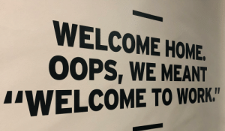Ethical brands in pandemic times
Step 3 – The workspace environment and atmosphere

Article series
COVID-19 impact
- Making healthy habits stick after COVID
- Shobservatory Research Chronicles: Lockdowndiaries
- Capturing early stage consumer feedback, post-COVID
- Evolution of physical space in retail and hospitality
- November 2021 COVID-19 forecast & commentary
- Ethical brands in pandemic times
- November 14 reforecast due to OSHA rule stay
- COVID-19 December 2021 forecast for the USA
- Omicron
- COVID-19 forecast in the USA
- COVID-19 update for the USA
- COVID-19 Omicron retrospective
- Crises and community
- Research that makes a difference
The global research on ethics (according to Millennials), conducted during the pandemic (https://esomar.org/newsroom/brand-ethics-in-pandemic-times), has brought to light the need to create work environments conducive to people's well-being.
The experience of working remotely amplified the desire and need to return to work in an atmosphere that makes people ‘feel at home’.

Millennials will represent the future workforce, the next generation of workers, and as employees, they have clearly expressed their desire to be able to work in a welcoming, safe, human and kind environment.
How to get it?
The third step, according to respondents, as essential to generate ethical behavior, is precisely how to ensure an environment and atmosphere in which people feel comfortable and can spontaneously express themselves.
We have talked about values (Step 1, https://esomar.org/newsroom/brand-ethics-in-pandemic-times) and the importance of consistency with the way the company relates to both the internal and external community, always remembering that respondents want a company to ‘say what it does and do what it says’.
Here are some practical tips and pointers, to convey how a company can behave, respecting its own values and mission, making people gain a sense of well-being, harmony and belonging:
Defining the identity of the company involving all the senses: a multi-sensorial atmosphere has to be experienced when entering this unique space. For example: happy colors (green, yellow), a calming scent (with a hint of flower/ vanilla/ lavender/ fruity scent), a pleasant and well selected music in the background, something to drink (i.e. water or a natural 100% fruit juice)
A comment from a respondent in Belgium: “The entrance should represent what the organization does. The atmosphere reflects with care and love, engaging all the senses.”
A thought from Argentina: “It should be a natural environment, with light colors, a nice smell such as vanilla and coconut”
Advice from a respondent in Germany: “Inside, the colors are only green and white, there’s calm music to make the people relaxed, free 100% fruit juice at the entrance.”
Human touch is fundamental as a part of a pleasant experience, i.e. a welcoming receptionist who’s ready to help, friendly and clearly enthusiastic to work for the company
An Italian respondent: “By the entrance the receptionist has a beautiful smile and good vibes, I imagine her or him taking care of the plants inside and being friendly, welcoming and kind with all. The person who welcomes 'home'.”
Light and transparency communicate authenticity and the pleasure of working in a place that inspires ideas, i.e. it is advised to bring lots of natural light from the big windows
From Italy: “White walls, big windows with lot of light. You can breathe healthy, clean air and feel inspired.”
A comment from America, “transparency in all its forms gives the idea of authenticity and trust”
Respect of personal and social safety: health comes first, so all respondents expect safety measures to be respected, from measuring body temperature at the entrance, to respecting interpersonal distance, to compulsory face masks, to periodic sanitation and the installation of columns with sanitizing gels.
From a French respondent: “safety must be guaranteed so that we can go back to work with peace of mind when sharing moments and spaces with colleagues”
Respect for nature: simple and minimalistic furniture, made in sustainable or recycled materials (i.e. wood, leather-free such as snappap as spontaneously suggested) and natural atmosphere through plants and trees positioned internally and externally and that can be directly cared for by employees:
A comment from Germany: “The furniture is leather-free, maybe made of something like snappap”
Congo: “I expect a green scenery, the feeling of breathing, the vegetation, all the furniture is made of wood, all the walls are made of glass and the daylight penetrates the building, in a natural way. That’s a perfect work environment”
Make people feel comfortable and encourage socialization: living room-like settings should be created, i.e. sofas can be placed in different areas of the building to give the sensation of being at home, making people more predisposed to share moments with colleagues:
A Spanish respondent: “Comfortable sofas can be placed around the building, to invite colleagues to take time to have conversation and exchange opinions, always respecting distances”
Highlight the commitment and results obtained on an individual, societal and environmental level: portraits and images of actions taken, relevant people in the company, results obtained would make the organization more recognizable, valuable and trustworthy.
From Belgium: “The environment should represent what the organization does: some posters of animals they saved, together with their employees, to show what the company cares about”
Ultimately, listening to Millennials around the globe, makes it clear that much care should be put in the choice of any element of the interior design to make everybody feel at ease and well-integrated in the work environment, which must communicate the essence and purpose of the company, in every single detail.
Our goal is to offer some ideas on how to take care of the well-being and state of mind of your co-workers.
Coming up next - the fourth step to become ethical and caring about the well-being of people inside and outside the company. We will focus on the internal community, on how to stimulate each employee's skills, the sense of belonging and the desire to collaborate and share.
For any further information or for sharing ideas and opinions, we would be pleased to hear you: info@almarqr.com
Giulia Fabrizi
Managing Director at Almar Quality ResearchAfter graduating in Social Psychology with a thesis on Colour Psychology, Giulia worked initially in Human Resources before moving on to Marketing Research, first focusing on Quantitative and later on Qualitative research at national and International level. She continued to acquire in-depth experiences on this sector over the years, using new methodologies to interpret consumer behaviour in this constantly changing world.
She is proud to be an ESOMAR member since 1995 and to have been ESOMAR Co-Representative for Italy over 4 years (2017-2021).
She is also member of Assocoaching as Business Coach, Team Coach and Parent Coach, Expert in Positive Psychology and certified facilitator in LEGO® SERIOUSPLAY® method.
Alena Silchenko
Intern at Almar Quality ResearchAlena Silchenko is Russian and she is a graduate of Erasmus University in Brussels. She studied Idea and Innovation Management: a new field that's all about turning great ideas into fantastic results that help the world to move forward and improve. It implies being creative but not in a traditional sense: it's about connecting the dots, seeing the bigger picture, finding the missing piece, looking at the situation from another perspective. Discovery of her passion for Qualitative Research through her studies, led her to an exciting internship with Giulia!
Article series
COVID-19 impact
- Making healthy habits stick after COVID
- Shobservatory Research Chronicles: Lockdowndiaries
- Capturing early stage consumer feedback, post-COVID
- Evolution of physical space in retail and hospitality
- November 2021 COVID-19 forecast & commentary
- Ethical brands in pandemic times
- November 14 reforecast due to OSHA rule stay
- COVID-19 December 2021 forecast for the USA
- Omicron
- COVID-19 forecast in the USA
- COVID-19 update for the USA
- COVID-19 Omicron retrospective
- Crises and community
- Research that makes a difference


